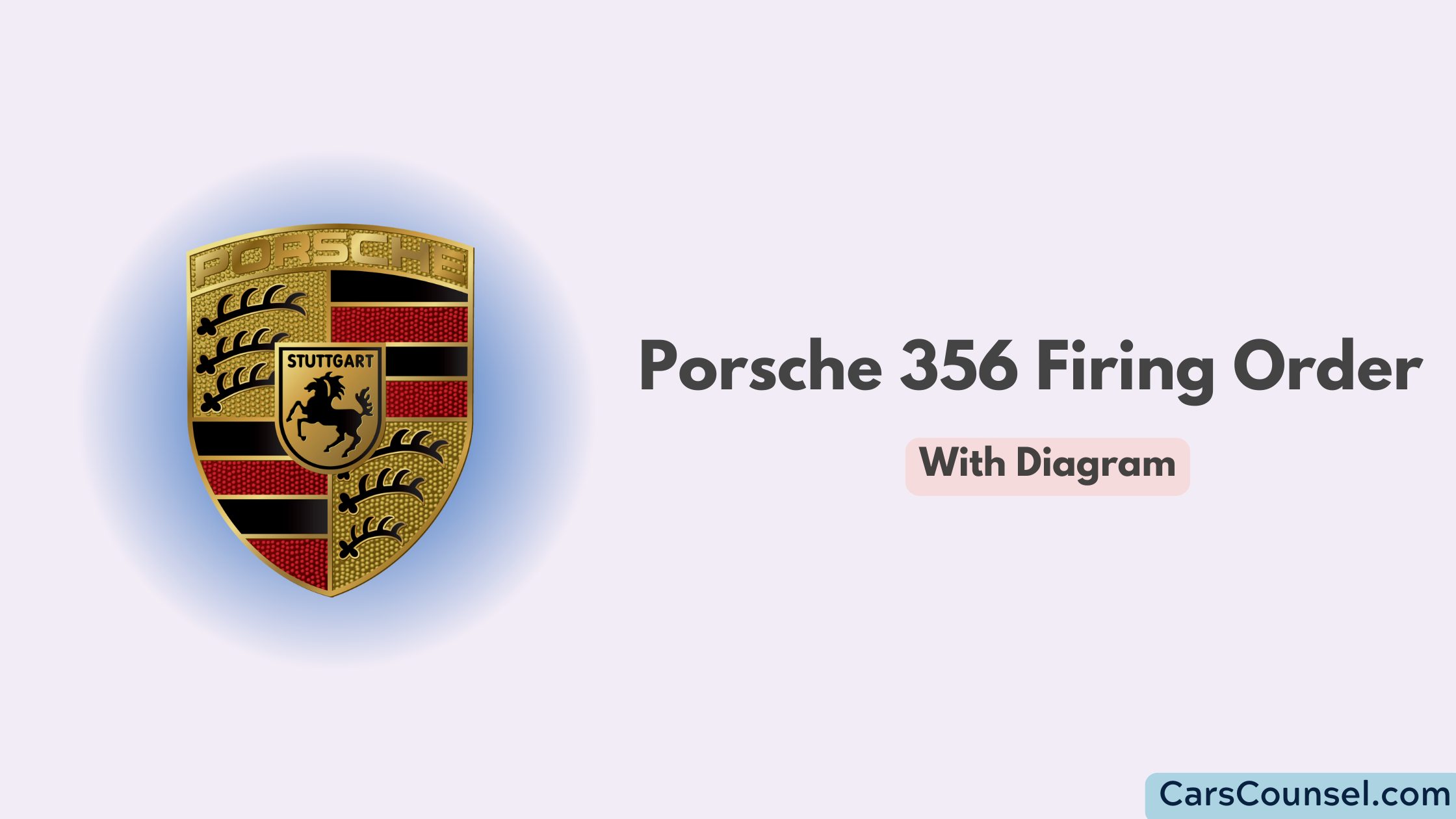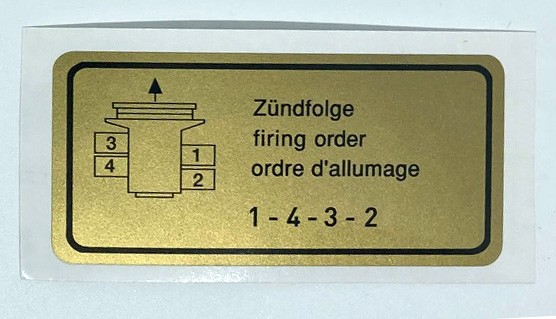The Porsche 356, an iconic sports car introduced in the late 1940s, is a symbol of Porsche’s engineering excellence. Powered by an air-cooled, flat-four engine, the Porsche 356 combines simplicity, performance, and reliability. One of the engine’s critical components is its firing order, the sequence in which the cylinders ignite to produce smooth and efficient power.
In this guide, we’ll explore the firing order of the Porsche 356 engine, why it matters, how it works, and tips for troubleshooting and maintenance. Understanding the firing order is essential whether you’re restoring a classic 356, maintaining its engine, or simply learning about its mechanics.

Quick Navigation
The Porsche 356 Firing Order
The firing order for the Porsche 356 engine is: 1-4-3-2

How the Firing Order Works
- Cylinder 1 Fires First: Located on the left bank, closest to the flywheel.
- Cylinder 4 Fires Next: Located on the right bank, furthest from the flywheel.
- Cylinder 3 Fires Third: Located on the right bank, closest to the flywheel.
- Cylinder 2 Fires Last: Located on the left bank, furthest from the flywheel.
This alternating sequence ensures smooth operation by balancing the firing events between the two banks of cylinders.
Why Porsche Uses the 1-4-3-2 Firing Order
The 1-4-3-2 firing order is tailored to the flat-four engine’s horizontally opposed layout. Here’s why it works:
- Balance: Alternating between left and right banks minimizes vibrations, improving stability and comfort.
- Efficient Combustion: Proper timing ensures complete combustion of the air-fuel mixture in each cylinder.
- Steady Power Output: Spacing the power strokes evenly delivers consistent torque.
- Durability: Reduces mechanical wear on the crankshaft and connecting rods by distributing forces evenly.
What Is a Firing Order?
The firing order is the specific sequence in which the engine’s spark plugs ignite the air-fuel mixture in the cylinders.
This combustion creates the power that drives the engine’s pistons and, ultimately, the vehicle. For horizontally opposed engines like the Porsche 356’s flat-four, the firing order is carefully designed to balance performance and minimize vibrations.
Why the Firing Order Matters
- Smooth Operation: Reduces engine vibrations and ensures consistent power output.
- Efficient Combustion: Proper sequencing optimizes air-fuel mixture combustion for better fuel economy.
- Engine Longevity: Minimizes mechanical stress, extending the lifespan of internal components.
- Balanced Power Delivery: Ensures a steady flow of torque for smooth acceleration.
Overview of the Porsche 356 Engine
The Porsche 356 is powered by a horizontally opposed four-cylinder engine. This air-cooled, flat-four layout is a hallmark of Porsche design, prioritizing a low center of gravity and compact packaging. Its simplicity and durability make it a favorite among classic car enthusiasts.
Key Features of the Porsche 356 Engine
- Flat-Four Configuration: Two cylinders on each side of the engine, horizontally opposed.
- Air-Cooled Design: Eliminates the need for a conventional liquid-cooling system.
- Four-Stroke Cycle: Operates on intake, compression, power, and exhaust strokes.
- Cylinder Numbering:
- Left Bank: Cylinders 1 and 2 (from front to rear).
- Right Bank: Cylinders 3 and 4 (from front to rear).
Identifying the Firing Order
Understanding and verifying the firing order is essential for maintaining and troubleshooting the Porsche 356 engine. Here’s how you can identify and apply it:
Cylinder Numbering
Knowing how the cylinders are numbered helps you follow the firing order correctly:
- Left Bank: Cylinders 1 and 2.
- Right Bank: Cylinders 3 and 4.
- Cylinders are numbered sequentially from front to rear, with Cylinder 1 closest to the flywheel.
Distributor Cap Orientation
The distributor rotor controls the firing sequence. Ensure the spark plug wires are routed from the distributor cap to the correct cylinders in the 1-4-3-2 sequence.
Symptoms of an Incorrect Firing Order
An incorrect firing order can cause several noticeable issues that affect engine performance and reliability. Recognizing these symptoms can help you diagnose and address problems quickly.
Common Symptoms
- Engine Misfires: Cylinders fail to ignite correctly, causing uneven power delivery.
- Rough Idling: The engine vibrates excessively or feels unstable when idle.
- Power Loss: Reduced acceleration and performance due to disrupted combustion.
- Backfiring: Combustion occurring in the intake or exhaust manifold due to improper ignition timing.
- Increased Fuel Consumption: Inefficient combustion leads to higher fuel usage and emissions.
Diagnosing and Fixing Firing Order Problems
If you suspect firing order issues in your Porsche 356 engine, follow these steps to diagnose and resolve them:
Diagnostic Steps
- Inspect Spark Plug Wires: Ensure each wire is routed to the correct cylinder based on the 1-4-3-2 firing order.
- Check the Distributor Rotor: Verify that the rotor aligns with the correct distributor cap terminal for each cylinder.
- Use a Timing Light: Confirm the ignition timing matches the engine’s specifications.
- Perform a Compression Test: Check all cylinders for adequate compression to ensure they’re firing properly.
Fixing Common Issues
- Reconnect Spark Plug Wires: Correctly route the wires to their corresponding cylinders.
- Adjust Distributor Timing: Use a timing light to align the rotor with the firing sequence.
- Replace Faulty Components: Install new spark plugs, ignition wires, or distributor caps if they’re damaged or worn.
Preventative Maintenance for Firing Order Reliability
Maintaining the correct firing order is essential for ensuring your Porsche 356 engine operates smoothly. Follow these preventative measures to avoid firing order issues:
Regular Inspections
- Check spark plugs, ignition wires, and the distributor cap for wear or corrosion.
- Inspect the rotor and ensure it aligns correctly with the distributor terminals.
Replace Components as Needed
- Replace spark plugs and ignition wires according to manufacturer recommendations.
- Use high-quality OEM components to maintain performance and reliability.
Verify Timing
- Periodically check ignition timing using a timing light.
- Realign the distributor timing whenever you replace ignition components or perform major engine work.
FAQs About the Porsche 356 Firing Order
Can I Change the Firing Order?
No, the firing order is fixed by the engine’s design and crankshaft configuration. Altering it would require significant mechanical modifications.
What Happens If the Firing Order Is Incorrect?
An incorrect firing order can cause misfires, power loss, rough operation, and potential damage to the engine’s internal components.
How Can I Verify the Firing Order?
Refer to the service manual, inspect cylinder numbering, and use timing tools to confirm the ignition sequence.
Is the Firing Order the Same for All Flat-Four Engines?
No, while many flat-four engines share the 1-4-3-2 firing order, some manufacturers use different sequences based on their engine designs.
Engines with Similar Firing Orders
Conclusion
The 1-4-3-2 firing order is a fundamental aspect of the Porsche 356 engine’s design, ensuring smooth performance, balanced power delivery, and efficient combustion. Understanding this sequence is essential for maintaining, troubleshooting, and optimizing the iconic flat-four engine.
By following proper maintenance practices, verifying ignition timing, and addressing issues promptly, you can keep your Porsche 356 running at its best. Whether you’re restoring a vintage model or enjoying one on the open road, knowing the firing order is a vital step in mastering the mechanics of this classic sports car.

